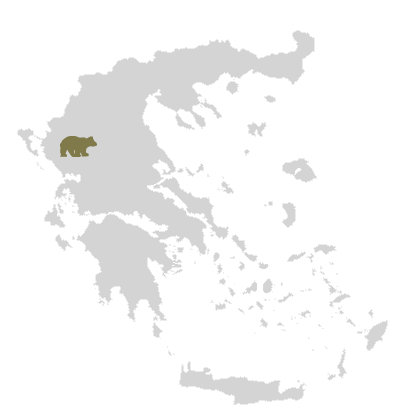Egyptian vulture

Egyptian vulture or “Asproparis” [Ασπροπάρης in Greek], an almost extinct wild species in the region of Zagori and the National Park of Vikos-Aoos in Greece.
The Egyptian vulture (Neophron percnopterus) is the smallest of the four species of European vultures. Its small size (wingspan of 180 cm (5.9 ft.) and body length of 60 cm (2.2 ft.)) have lead to its other Bulgarian name: ‘lesser vulture’. The adults have white plumage with black flight feathers and featherless yellow-orange face. The crest of white, pointed feathers gives the bird its typical appearance. The tail is white and wedge-shaped. The young are dark brown with light feather tips. As they mature the dark juvenile feathers are gradually replaced with the typical white of the adults. The bird reaches adult plumage in its fifth or sixth year. In flight it can be mistaken for a white stork. The differences are the wedge-shaped tail and the short legs and neck.
 The Egyptian vulture is a globally endangered species, included in the IUCN Red List as “Endangered”. Its global population is estimated at 21 000-67 000 individuals with a steady negative tendency. It is strictly protected by the Bern and Bon International Conventions, as well as by the Convention on International Trade in Endangered Species (CITES). In the past the Egyptian vulture was wide-spread throughout Bulgaria and Greece with high population numbers. Today the Balkan Peninsula is home to less than 90 pairs. The species is included in the Bulgarian Red List and is protected under the Biodiversity Act.
The Egyptian vulture is a globally endangered species, included in the IUCN Red List as “Endangered”. Its global population is estimated at 21 000-67 000 individuals with a steady negative tendency. It is strictly protected by the Bern and Bon International Conventions, as well as by the Convention on International Trade in Endangered Species (CITES). In the past the Egyptian vulture was wide-spread throughout Bulgaria and Greece with high population numbers. Today the Balkan Peninsula is home to less than 90 pairs. The species is included in the Bulgarian Red List and is protected under the Biodiversity Act.
The Egyptian vulture prefers open hills and low mountain ranges. Its main nesting sites are cliffs and rocky slopes, often close to human settlements. The nest is located in niches, ledges and crevices in the cliff face. One nest is usually occupied for several years. The species is monogamous; in Ancient Egypt it was revered as a symbol of parental care.
 The Egyptian vulture is a migrant. In September both young and adults fly south to spend the winter months in Africa. In spring they fly over thousands of kilometers back to their nesting territories. As soon as the pairs arrive in March-April both birds start improving the nest. First they build or strengthen the base by entwining twigs and branches; then they meticulously cover the interior with wool and rags. In the end the nest is decorated with bones, tortoise shells and other leftovers from their diet. In April-May the female lays 1-3 eggs. Both parents sit on the eggs.
The Egyptian vulture is a migrant. In September both young and adults fly south to spend the winter months in Africa. In spring they fly over thousands of kilometers back to their nesting territories. As soon as the pairs arrive in March-April both birds start improving the nest. First they build or strengthen the base by entwining twigs and branches; then they meticulously cover the interior with wool and rags. In the end the nest is decorated with bones, tortoise shells and other leftovers from their diet. In April-May the female lays 1-3 eggs. Both parents sit on the eggs.
The Egyptian vulture, as other vultures, feeds mainly on carrion. Therefore the vulture family is known as ‘nature’s caretakers’. The Egyptian’s diet also includes insects, larvae, frogs, lizards and tortoises which it catches alive. It can be seen patrolling the roads in search for road kill. It also frequents local dumpsites. The bird is well-known for its intelligence – it’s among the few bird species in the world to use tools. In Africa the vulture can often be seen breaking abandoned ostrich eggs using a stone.
The Egyptian vulture is an Indo-African species. It is distributed widely across areas in the Indian and the Arabian Peninsulas, the vast steppes of Central Asia, the open hills of South Europe and the hot sands of Africa. Nowadays the Egyptian vulture faces extinction and its area of distribution is shrinking. In the past it was wide-spread in Bulgaria with records of pairs nesting even on the hills in the city of Plovdiv. Today one of the last and most secure haven for the species are the Eastern Rhodope Mountains. It can still be seen also in Russenski Lom, on the Provadiisko and Royaksko Plateaus, as well as in Eastern Balkan Mountain.
The Egyptian vulture is a typical long-distance migrant. In September both young and adult birds leave the nesting territories of the species and start a long journey towards their wintering places in Africa. They migrate in small groups, mainly over land, avoiding long distances over open sea, although some individuals from the southwestern Balkan population regularly cross the Mediterranean Sea. They fly over Turkey and the eastern shores of the Mediterranean Sea and enter African land. Along the migration routes, they gather in great numbers at places with an abundance of food such as dumpsites and feeding stations. In spring the Egyptians cover over 4 000 km (2 500 mi.) back to their nesting territories – it takes them about 30-40 days. The migration is a critical ordeal for the young birds in particular, as they have less experience and there are a lot of dangers on the way.
More at lifeneophron.eu
 Nature in Greece | Mountains, lakes, forests, fauna and flora
Nature in Greece | Mountains, lakes, forests, fauna and flora









